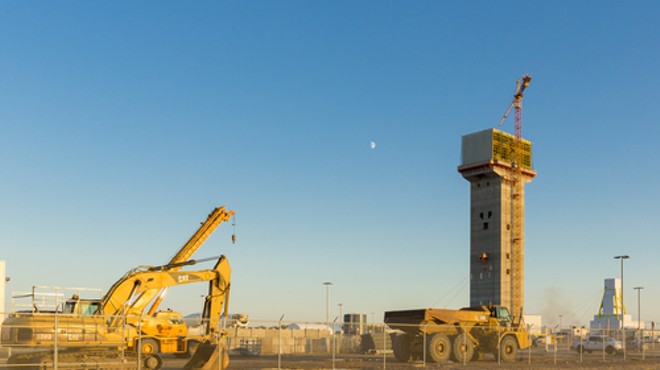Early on a weekday afternoon, the lunch rush is coming to an end at the Remus Tavern in Mecosta County, near the crossroads of M-20 and M-66. About 17 miles west of Mount Pleasant, Remus is an unincorporated village smack in the center of Wheatland Township, and 120 miles northwest of Detroit. Several of the customers wear hunting fatigues, and the walls are decorated with mounted moose and deer heads.
That said, the little town has a connection to big-city Detroit, because at least somebody here is a huge Red Wings fan. Red Wings autographs adorn the menus, the portraits on the walls. All told, there are probably more signatures of Red Wings players here than at the home office of Olympia Entertainment.
At a table up front near the window, Jeff Ostahowski, the vice president of Michigan Citizens for Water Conservation, is having a Stroh’s Michelada. He’s no radical firebrand. He’s an inventor and technician, a guy who radiates quiet pride when discussing his work with controlled microbes designed to help digest grease molecules.
But that’s not why he’s invited us to mid-Michigan for a beer. Ostahowski has a warning for his fellow Michiganders, mostly related to a proposed potash (pronounced POT-ash) mine in Osceola County. The project had been the subject of a March 16 article in The Detroit Free Press, under a headline hailing the project as a $700 million investment aimed at the $65 billion prize: a large reserve of high-quality potash, or potassium chloride, 1.5 miles underground. A Colorado geologist and engineer, Ted Pagano, founder of a company called Michigan Potash, hopes to exploit the deposit, which is used as an agricultural fertilizer. Pagano has bought up hundreds of leases around a test drill site that yielded high levels of potash, and is quoted as calling his plant “transformational” and “generational.”
In short, it’s just the kind of story to get impoverished rural families excited about jobs and to get the Department of Environmental Quality primed to issue permits.
Ostahowski, however, doesn’t seem so giddy about the prospects for a mine. Quizzed about his reaction to the article, he says, “I didn’t think he had it exactly right. My group opposes it for a variety of reasons. First, the site that’s selected is probably the worst possible site anyone could select. It’s right in the middle of four wetlands. One in every direction.”
Ostahowski also doesn’t seem impressed by Michigan Potash’s leader, Ted Pagano, whom his group calls “an absentee entrepreneur.”
“He’s only been involved with one other potential potash mine," he says. "He got the permits for a mine in North Dakota and didn’t actually do any drilling. ... A British company put down a well and decided that the potash wasn’t of a sufficient grade to bother with so it was a total loss for them.”
This wouldn’t be Osceola County’s first go-round with potash mining. Within a few miles of the proposed site for the new potash mine, another mine had already been sunk in 1983 for Pittsburgh Paint and Glass. Ostahowski suspects the operation will go bust like the others.
“There’s been three Fortune 500 companies trying to make money on this right there,” Ostahowski says. In fact, he adds that another reason his group opposes the project is because, instead of digging test wells on its proposed site, Michigan Potash’s application with MDEQ relied on PPG data so old as to be of questionable value.
“They’re using the data that was put together by Pittsburgh Paint and Glass 37 years ago,” Ostahowski says, pointing out Michigan Potash’s reliance on data from 36 wells drilled in the early 1980s.
“We’ve had a 4.2 earthquake down near Kalamazoo in May of 2015,” Ostahowski says. “According to the geologists, a 4.2 earthquake can affect the strata anywhere within a 200-mile radius of the epicenter. This potential mine is within 100, maybe 105 miles of that epicenter. They’ve dug no wells, they have no actual data. … It’s not good science.”
Then Ostahowski discusses the economic factors that make this kind of deep solution drilling unprofitable. The kind of deep injection mining Pagano proposes “costs at least $400 to $500 if not $600 a ton just to do it,” Ostahowski says. “A month ago, [potash] was at $240. If it costs you $400 or $500 a ton to get it and you can sell it for maybe a premium of $260, or maybe $280, because it’s pretty good potash. … The problem is there’s a tremendous supply of potash that’s already dug ... in Canada. Some people have said it’s a 5,000-year supply that’s already dug and waiting to be shipped.”
Ostahowski fears the state will use its power to make the mine more economically viable, building access roads or speeding through permits, instead of to protect aquifers, endangered species, and life-giving groundwater from wasteful exploitation.
“More than 4 million Michiganders rely on groundwater for daily drinking water,” Ostahowski says. “And Michigan has the largest number of wells in the country, by state. Groundwater supplies are increasingly endangered.”
Of the 1,200 gallons per minute of water — that’s 1.7 million gallons of fresh, clean water per day — needed to run a potash injection mine, Ostahowski says, “You’ll never use that water again, ever. They pump it up with the crystals in it, dry the crystals out, and what’s left is highly toxic … and they’ve got three disposal injection wells and they pump it [back underground] and it’s gone for good. Or so they say. We can only hope.”
And injecting waste deep into the ground in Michigan is something people in the oil and gas industry know plenty about. For years, they’ve used millions of gallons of fresh water to shake oil and gas to the top, then have taken the resulting toxic brine and shot it into deep wells in the ground.
But Pagano has also applied for permits for three processed brine disposal wells for the water polluted by the potash-mining process. And when it comes to shooting waste into the ground, Michigan has plenty of experience with that. One reason, Ostahowski says, is simple geology.
“One of the issues we have in our state is because of what they call the Dundee Geologic Formation. It’s basically a basin curvature, and our DEQ as well as the EPA believe that it’s ideal for depositing waste,” Ostahowski says. “So we are the king of injection wells east of the Mississippi.”
In fact, Michigan has 1,700 injection disposal wells monitored by the EPA. The rest of the region — encompassing Ohio, Indiana, Illinois, Wisconsin, and Minnesota — has only 100 injection disposal wells in total.
“We need to stop using those 1,700 wells to bury brine, and we need to stop using fresh water to enhance oil and gas production, and we need to use that toxic brine to enhance oil and gas production,” Ostahowski says. “It works just fine out West. It will work just fine here. It’s not as handy. It costs a little more to do it that way. But we don’t destroy the fresh water. Because once it goes down, it’s gone. Using the brine that’s produced in that field, over again in that field, only makes sense. Particularly when you don’t have to destroy the fresh water.”
The toxic mix of fracking, brine, and injection wells isn’t just something that might cause bigger problems. The problems are already documented in Oklahoma.
“Fifteen years ago,” Ostahowski tells us, “Oklahoma might have had two or three earthquakes, and they might not have been 4 [on the Richter scale] or above. About three years ago … the scale tipped. They started getting more than three a day. They average more than three a day. ...
“My point in all this is that ... what happened to Oklahoma is only a matter of physics,” he ays. “It doesn’t matter what your formation is. If you keep putting all that brine down there, it weighs a little over eight pounds a gallon and the average well in Michigan gets maximum of 210,000 gallons a day, or 1.75 million pounds of contaminants a day. One of our issues in Michigan is, once you get an injection well, it’s ad infinitum. They don’t say, ‘Here’s your limit.’ You’ve got a daily limit. But there’s no long-term limit. We need long-term limits on what you can put in any injection well.”
To learn more about Michigan Citizens for Water Conservation, see savemiwater.org.
Stay on top of Detroit news and views. Sign up for our weekly issue newsletter delivered each Wednesday.




